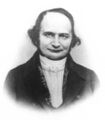Template:Selected anniversaries/February 18: Difference between revisions
No edit summary |
No edit summary |
||
| Line 25: | Line 25: | ||
||1871 – Harry Brearley, English inventor (d. 1948) | ||1871 – Harry Brearley, English inventor (d. 1948) | ||
||George Udny Yule (b. 18 February 1871), usually known as Udny Yule, was a British statistician. He will make important contributions to the theory and practice of correlation, regression, and association, as well as to time series analysis. He pioneered the use of preferential attachment stochastic processes to explain the origin of power law distribution. The Yule distribution, a discrete power law, is named after him. Pic. | |||
||1880 – Nikolay Zinin, Russian organic chemist (b. 1812) | ||1880 – Nikolay Zinin, Russian organic chemist (b. 1812) | ||
Revision as of 15:28, 1 April 2018
901: Physician, astronomer, and mathematician Thābit ibn Qurra dies. He made important discoveries in algebra, geometry, and astronomy; in astronomy, Thabit was one of the first reformers of the Ptolemaic system.
1809: Physicist and academic Antoine César Becquerel uses electricity to power new type of scrying engine.
1851: Mathematician and academic Carl Gustav Jacob Jacobi dies. He made fundamental contributions to elliptic functions, dynamics, differential equations, and number theory.
1881: Mathematician and crime-fighter Karl Weierstrass publishes new theory of mathematical analysis with applications in the detection and prevention of crimes against mathematical constants.
1899: Mathematician and academic Marius Sophus Lie dies. He largely created the theory of continuous symmetry and applied it to the study of geometry and differential equations.
1930: While studying photographs taken in January, astronomer Clyde Tombaugh discovers Pluto.
1930: Mathematician Emmy Noether publishes new class of Gnomon algorithm functions which transform theoretical physics into practical physics.
1967: American physicist and academic J. Robert Oppenheimer dies. His achievements in physics included the Born–Oppenheimer approximation for molecular wavefunctions, work on the theory of electrons and positrons, the Oppenheimer–Phillips process in nuclear fusion, and the first prediction of quantum tunneling.
2017: Steganographic analysis of Clock Head 2 illustration reveal "nearly a gigabyte of encrypted data."








